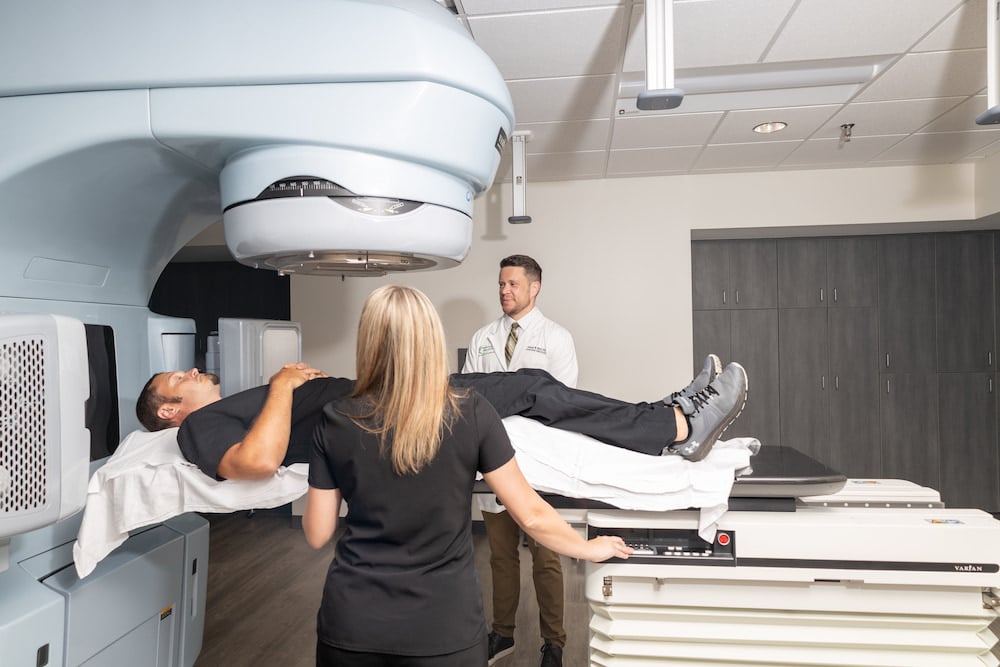
The effectiveness of cancer treatments continues to improve, leading to a better quality of life and higher survival rates for cancer patients. Researchers are finding new ways to combine therapies and developing new treatment methods.
High-intensity focused ultrasound (HIFU) is a relatively new treatment option that uses ultrasound waves to treat some types of cancer as well as non-cancerous tumors in the bones, breast, prostate, brain, liver, kidneys, and pancreas.
The main difference between radiation therapy and HIFU is the type of energy used – high-energy x-rays versus high-intensity sound waves that destroy the cancer. While effective, HIFU is not a treatment option for every patient. Let’s look at the two therapies and how they can be used.
How Does Radiation Therapy Work to Treat Cancer?
Radiation therapy (or radiotherapy) is often part of the cancer treatment process. Radiation therapy damages cancer cells' DNA (instructions for cells), which stops them from dividing and growing.
Radiation therapy is a versatile treatment that can be used in several ways. It can be:
- The primary treatment for cancer
- Used before surgery to shrink tumors so there is less to remove
- Given after surgery to kill any remaining cancer cells left behind in the surgery that could not be seen with the naked eye
- Used to ease pain and other symptoms in late-stage cancers
Radiation therapy can be administered from an external or an internal source. External beam radiation therapy (EBRT), the most commonly used method, targets high-energy radiation beams at the cancer from a machine called a linear accelerator outside the body. There are several types of EBRT. A radiation oncologist will review your specific needs, including the type, size, and tumor location, to determine what will work best. Treatments are usually given five days a week for a few weeks.
Internal radiation is called brachytherapy. For prostate cancer, tiny radioactive seeds or pellets are surgically implanted inside the body and allowed to break down slowly over time, releasing the proper dose of radiation to the tumor to kill the cancer. For some cancers, such as breast cancer, the pellets are placed temporarily for a few minutes into the breast through a surgically implanted applicator. This process is repeated a few times over the course of several days to complete the treatment.
Radiation Therapy Side Effects
As with many cancer treatments, there are some side effects to be expected. Side effects differ for each person and depend on where the radiation is delivered to the body.
Short-term side effects can include:
- Fatigue
- Nausea/vomiting
- Diarrhea, especially if radiation is directed to the bowel area
- Erectile dysfunction while going through treatment if given radiation to the prostate
- Blood in the urine if given in the lower abdomen for the bladder or prostate
- Hair loss in the area where external beam radiation was directed
- Skin changes such as redness or peeling in the area where radiation was delivered
- Dry mouth or difficulty swallowing, especially if the radiation is delivered to oral cavity or neck area
- Shortness of breath if radiation is delivered in the chest area
- Irritation or infection at the surgery site with brachytherapy
Although most side effects start improving after treatment ends, some patients have long-term side effects such as arm or leg swelling (lymphedema), scarring (fibrosis), or secondary cancers. Other side effects can develop months or years after treatment has ended.
How Does HIFU Work?
High-intensity focused ultrasound (HIFU) is a minimally invasive treatment that uses powerful ultrasound waves to treat cancer. Carefully focused sound waves act on cancerous tumors and modify or destroy them. They cause the tumor’s temperature to increase, and the intense heat destroys it. Ultrasound beams go through layers of skin, muscle, and other tissue without affecting them. HIFU is like a magnifying glass that focuses sunlight on a target and burns it.
Its most common use is for early-stage, slow-growing prostate cancer. It can be an alternative to active surveillance. It’s not effective for prostate cancer that has developed beyond the prostate. In some cases, it’s also used after radiation or surgery if these two methods have failed to eliminate small, locally confined prostate cancer.
There are some side effects of HIFU. While some are similar to radiation therapy for prostate cancer, others are not. These should go away on their own within a few weeks after treatment:
- Blood in the urine
- Difficulty passing urine (if the prostate has swollen)
- Erectile Dysfunction
- Pain in the area between the testicles and rectum
Pros and Cons of HIFU for Cancer Treatment
HIFU has both advantages and disadvantages compared to radiation therapy. HIFU advantages include:
- Targets cancer without damaging surrounding tissues
- Requires one treatment session, usually as an outpatient
- Shorter recovery time
- For some patients, it eliminates the need for additional treatments such as radiation, chemotherapy, or surgery
HIFU’s disadvantages are:
- It can only treat limited types of cancer. The cancer must be clearly visible on a magnetic resonance imaging (MRI) or ultrasound scan. A clear image permits the tumor to be precisely targeted. If the cancer has spread, HIFU cannot target it accurately.
- Late-stage or higher-grade cancers are not treatable with HIFU.
- You’ll need several MRI (or ultrasound) scans to guide the focusing of the high-energy beams on the tumor. MRIs are also used to determine if HIFU destroyed the cancer.
- Rarely, HIFU can cause skin burns.
How Do Radiation Therapy and HIFU Compare?
HIFU provides precision targeting and is generally restricted to small, easily detected cancers that have not spread. Radiation can be used on almost any type of cancer. There are side effects with both treatments, some of which are similar.
External beam radiation therapy requires multiple treatment sessions. Brachytherapy requires surgery and anesthesia to insert the radioactive pellets on or near your tumor. HIFU is usually completed in one session but can require anesthesia to place the ultrasound equipment into the rectum.
HIFU is most often given by a urologist in an outpatient procedure for prostate cancer. A radiation oncologist administers external beam radiation therapy at a cancer center. Treatments are usually five days a week for a few weeks. Brachytherapy is a one-time surgical procedure to place the seeds in the prostate. The radiation oncologist will determine the dose and often also performs the procedure.
How Do I Know What’s Right For Me?
When comparing radiation therapy and HIFU, it’s crucial to have a clear understanding of your treatment goals and objectives and to consider your cancer type, stage, location, and overall health. If you haven’t met with an oncologist, it’s a good idea to schedule a consultation before choosing any treatment, whether it’s surgery, HIFU, or radiation therapy.
Your oncologist will develop a customized cancer treatment plan for your specific needs. Ask them about how their plan compares to HIFU and why they would or would not recommend it. An informed decision means you understand the various treatments and their side effects before choosing one you and your loved ones are comfortable with.
If HIFU is an option for you, be sure you understand:
- Your exact cancer diagnosis, including the type, location, stage, and all the treatment options. Insurance will typically cover appointments for treatment planning and second opinions.
- Benefits and potential risks for each cancer treatment method
- If active surveillance is an option, understand the risks and benefits.
- Potential treatment side effects, both short- and long-term
- Time spent in treatment, including travel to treatments. If you choose external beam radiation therapy as part of your treatment, be sure to select a cancer center that’s convenient for you.
- Recovery time
- Need for hospitalization and anesthesia
- If your health is strong enough to endure treatments
By understanding your treatment goals and the specifics of each treatment method, including the potential outcomes of each treatment, you are in a good position to make an informed decision about your treatment.
Radiation Oncologists in the Greater Atlanta Area
Cancer patients in the greater Atlanta area can receive expert radiation therapy treatment close to home at any of the radiation therapy centers in Conyers, Covington, Decatur, and Snellville, Georgia. Request a consultation to understand your treatment options better.




